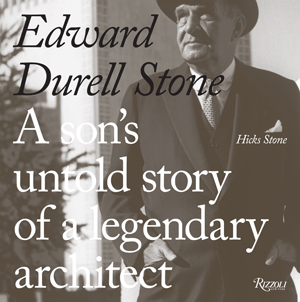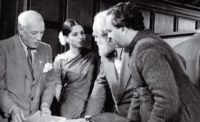This biography of Ed Stone by his architect son Hicks is a highly personal story of the rather melodramatic life of an architect who came to exemplify the best and worst of the 1950s. Like his fellow Arkansan, Bill Clinton, Ed Stone's rural roots engendered a Southern charm that propelled him to the center of Washington's inner circle and helped him win the commissions to design the U.S. Embassy in India (1954), the U.S. Pavilion at the 1958 Brussels Worlds fair, and the Kennedy Center (1962). Like Clinton, he had a reputation as a womanizer, eventually marrying thrice. His second marriage ended with his wife Maria rampaging through his office, creating headlines in the Daily News. (It was the pretentious Maria, who bestowed on him the Edward Durell portion of his name.)

Interesting as much for the sociology of the times—the Mad Men escapades of drinking and carousing—this book charts the intersection of architecture and soap opera. In one section, it connects Stone’s friendship with Frank Lloyd Wright—and especially Wright's last wife Olgivanna—directly to the breakup of Stone's second marriage. On top of this, increasingly negative architectural criticism of his work eventually destroyed Stone’s reputation as a serious architect—turning academia, the press, and the public against him. Certainly, his Huntington Hartford Museum at 2 Columbus Circle in New York would not have been altered beyond recognition in 2008 to house the Museum of Art and Design had his projects been better appreciated.
Stone’s work was the opposite of the masculine Brutalism that developed in the 1950s and '60s as one response to the thin planes of the International Style. His delicate wrapping of boxes with shimmering grilles, like those at his embassy in New Delhi, can be seen today in the perforated skins and exoskeletons of the most contemporary avant-garde architects. Are not the exterior meshes of Thom Mayne’s buildings, wrapped in academic obfuscation, the direct descendant of Stones grilles? As this book notes, Eero Saarinen decried Stone for such elements. “The best thing that could happen to Ed Stone is for someone to take his grilles away from him.” Are not the mute, veiled cubes of Stone’s University of South Carolina dorms the inspiration for various decorative works by Koolhaas and Herzog & de Meuron? It was Rem, in fact, who revived interest in the “flaccid curves” of Wallace Harrison’s oeuvre, and Ed Stone once worked in Harrison's office.
The rise and fall of Edward Durell Stone, from the heights of promise as the architect of the Museum of Modern Art (with Philip Goodwin) in 1937 is a cautionary tale about the limited ability of “starchitects” to maintain their reputations in a single trajectory. (Think Morris Lapidus, Paul Rudolph, and Michael Graves.) While history has the advantage of the long view, an architect's reputation and the quality of his work can be obscured for generations by the buzz of negative publicity in his lifetime.
Hicks Stone’s book is a lovingly told and disarming story of his father, warts and all, an engaging read about an architect who may, after all, be on the verge of a revival.
Alexander Gorlin is a New York architect and the author of Tomorrow’s Houses: New England Modernism and other books.






Post a comment to this article
Report Abusive Comment